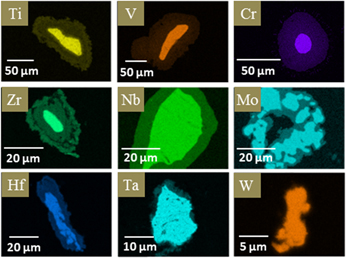Crossref Citations
This article has been cited by the following publications. This list is generated based on data provided by
Crossref.
Shi, Xiao-Lei
Zou, Jin
and
Chen, Zhi-Gang
2020.
Advanced Thermoelectric Design: From Materials and Structures to Devices.
Chemical Reviews,
Vol. 120,
Issue. 15,
p.
7399.
Xing, Tong
Song, Qingfeng
Qiu, Pengfei
Zhang, Qihao
Gu, Ming
Xia, Xugui
Liao, Jincheng
Shi, Xun
and
Chen, Lidong
2021.
High efficiency GeTe-based materials and modules for thermoelectric power generation.
Energy & Environmental Science,
Vol. 14,
Issue. 2,
p.
995.
WANG, Xu
GU, Ming
LIAO, Jincheng
SONG, Qingfeng
SHI, Xun
BAI, Shengqiang
and
CHEN, Lidong
2021.
High Temperature Interfacial Stability of Fe/Bi0.5Sb1.5Te3 Thermoelectric Elements.
Journal of Inorganic Materials,
Vol. 36,
Issue. 2,
p.
197.
Bai, Shengqiang
Zhang, Qihao
and
Chen, Lidong
2021.
Thermoelectric Energy Conversion.
p.
469.
Jayachandran, B.
Prasanth, B.
Gopalan, R.
Dasgupta, T.
and
D., Sivaprahasam
2021.
Thermally stable, low resistance Mg2Si0.4Sn0.6/Cu thermoelectric contacts using SS 304 interlayer by one step sintering.
Materials Research Bulletin,
Vol. 136,
Issue. ,
p.
111147.
Jia, Yanhua
Jiang, Qinglin
Sun, Hengda
Liu, Peipei
Hu, Dehua
Pei, Yanzhong
Liu, Weishu
Crispin, Xavier
Fabiano, Simone
Ma, Yuguang
and
Cao, Yong
2021.
Wearable Thermoelectric Materials and Devices for Self‐Powered Electronic Systems.
Advanced Materials,
Vol. 33,
Issue. 42,
Bu, Zhonglin
Zhang, Xinyue
Hu, Yixin
Chen, Zhiwei
Lin, Siqi
Li, Wen
and
Pei, Yanzhong
2021.
An over 10% module efficiency obtained using non-Bi2Te3 thermoelectric materials for recovering heat of <600 K.
Energy & Environmental Science,
Vol. 14,
Issue. 12,
p.
6506.
Nam, Woo Hyun
and
Cho, Jung Young
2021.
A Brief Review of CoSb3-based Thermoelectric Materials and Modules for Mid-Temperature Power Generation.
Ceramist,
Vol. 24,
Issue. 2,
p.
213.
Coelho, Rodrigo
De Abreu, Yassine
Carvalho, Francisco
Branco Lopes, Elsa
and
Gonçalves, António Pereira
2022.
An Electrical Contacts Study for Tetrahedrite-Based Thermoelectric Generators.
Materials,
Vol. 15,
Issue. 19,
p.
6698.
Hu, Boxuan
Shi, Xiao-Lei
Zou, Jin
and
Chen, Zhi-Gang
2022.
Thermoelectrics for medical applications: Progress, challenges, and perspectives.
Chemical Engineering Journal,
Vol. 437,
Issue. ,
p.
135268.
Xie, Li
Ming, Chen
Song, Qingfeng
Wang, Chao
Liao, Jincheng
Wang, Lei
Zhu, Chenxi
Xu, Fangfang
Sun, Yi-Yang
Bai, Shengqiang
and
Chen, Lidong
2023.
Lead-free and scalable GeTe-based thermoelectric module with an efficiency of 12%.
Science Advances,
Vol. 9,
Issue. 27,
Min, Erbiao
Ling, Yifeng
Zhao, Linghao
Xu, Ying
Gao, Li-Yin
Li, Juan
Feng, Jianghe
Zhang, Ping
Liu, Ruiheng
and
Sun, Rong
2023.
Extremely Low Contact Resistivity of Bi2Te3-Based Modules Enabled by NiP-Based Alloy Barrier.
ACS Applied Materials & Interfaces,
Vol. 15,
Issue. 50,
p.
59066.
Wu, Xinzhi
Lin, Yangjian
Liu, Chengyan
Han, Zhijia
Li, Huan
Wang, Yupeng
Jiang, Feng
Zhu, Kang
Ge, Binghui
and
Liu, Weishu
2023.
Interface Engineering Boosting High Power Density and Conversion Efficiency in Mg2Sn0.75Ge0.25‐Based Thermoelectric Devices.
Advanced Energy Materials,
Vol. 13,
Issue. 32,
Liu, Min
Zhang, Xinyue
Wu, Yixuan
Bu, Zhonglin
Chen, Zhiwei
Li, Wen
and
Pei, Yanzhong
2023.
Screening Metal Electrodes for Thermoelectric PbTe.
ACS Applied Materials & Interfaces,
Vol. 15,
Issue. 4,
p.
6169.
Hong, Min
Li, Meng
Wang, Yuan
Shi, Xiao‐Lei
and
Chen, Zhi‐Gang
2023.
Advances in Versatile GeTe Thermoelectrics from Materials to Devices.
Advanced Materials,
Vol. 35,
Issue. 2,
Mu, J. P.
Wang, L.
Liu, X. S.
and
Zhao, D. G.
2024.
Research on the Thermal Stability of MoCu/CoSb3 Thermoelectric Junction with CoCrFeNi High-Entropy Alloy Barrier Layer.
Journal of Materials Engineering and Performance,
Peng, Liming
Xing, Tong
Qiu, Pengfei
Liao, Jincheng
Gu, Ming
Zhu, Chenxi
and
Shi, Xun
2024.
Metallic barrier layer for Ag2S1−xSex inorganic ductile thermoelectric materials.
Applied Physics Letters,
Vol. 124,
Issue. 15,
Fu, Yuntian
Ai, Xin
Hu, Zhongliang
Zhao, Shuhan
Lu, Xiaofang
Huang, Jian
Huang, Aibin
Wang, Lianjun
Zhang, Qihao
and
Jiang, Wan
2024.
Interface kinetic manipulation enabling efficient and reliable Mg3Sb2 thermoelectrics.
Nature Communications,
Vol. 15,
Issue. 1,
Palaporn, Dulyawich
Tanusilp, Sora-at
Sun, Yifan
Pinitsoontorn, Supree
and
Kurosaki, Ken
2024.
Thermoelectric materials for space explorations.
Materials Advances,
Vol. 5,
Issue. 13,
p.
5351.
Ying, Pingjun
Villoro, Ruben Bueno
Bahrami, Amin
Wilkens, Lennart
Reith, Heiko
Mattlat, Dominique Alexander
Pacheco, Vicente
Scheu, Christina
Zhang, Siyuan
Nielsch, Kornelius
and
He, Ran
2024.
Performance Degradation and Protective Effects of Atomic Layer Deposition for Mg‐based Thermoelectric Modules.
Advanced Functional Materials,
Vol. 34,
Issue. 45,
